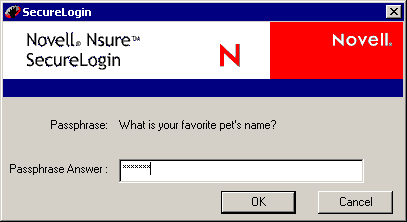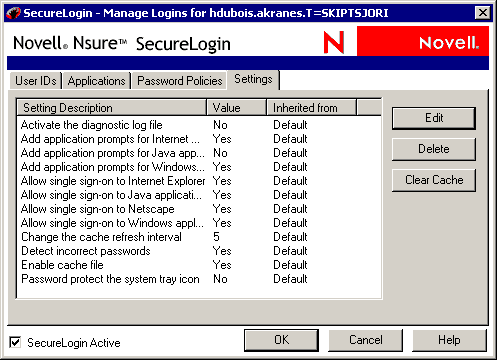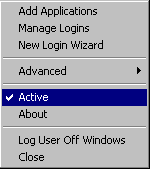Right-click the SecureLogin icon on the system tray.
Click Advanced > Change Passphrase.
Type your existing passphrase answer.

Edit the passphrase question, passphrase answer, or both, then click OK.
As the following figure illustrates, users with access to the SecureLogin icon on the system tray can apply settings to a workstation:

The list in the Setting Description column is a subset of settings you control through ConsoleOne. For information on these and the complete list, see Configuring SecureLogin Settings.
To clear the entries in the local cache, click Clear Cache. The cache file is updated at the next refresh. You might want to clear the cache if SecureLogin behaves strangely (for example, loss of sync with passwords, or having multiple credential sets when only one should exist).
So that you can use login data when you work offline (for example, on a disconnected laptop), you can store login data in encrypted files on your workstation.
If you forget the passphrase answer password and are not able to log in using your directory password, you will have to delete and recreate the cache files. SecureLogin automatically re-creates cache files, provided you are authenticated to the network.
The only time a user needs to delete a local cache is when the user is locked out of both the directory and the local cache. This would happen if you as administrator reset the user's password and the user can't remember the passphrase answer. You would then go to the User object in ConsoleOne and clear user data. The user would then need to delete the local cache files and add login information again.
To disable the cache:
Double-click the SecureLogin icon on the system tray.
Click Settings > Enable Cache File.
Set the value to No, then click OK.
You can use the Active setting to override all the settings and disable SecureLogin.
Scenario: Writing a New Script. You have started writing a script for an application. Because you need to inspect some control IDs with Window Finder, you do not want the script to run at this time. You disable the Active setting. SecureLogin doesn't run while you fine-tune the script. After troubleshooting, you click Active. SecureLogin is functional again.
Scenario: Troubleshooting an Existing Script. You have a script already written for an application. You open the application to get more information from it, so that you can put the information in your script. Because the Active setting is used, the script for the application runs.
You don't want to wait for the script to run while you look for control IDs. Therefore, you close the application, click Active to disable SecureLogin, then open the application. You then get the information that you need, return to your script, enter the information into the script, toggle to Enable, then run the script.
The Active setting can also be useful for the help desk to use in troubleshooting, so that a technician can manually step through a login.

To toggle the Active setting:
If the network administrator allows you to, you can change a passphrase question and answer:
Right-click the SecureLogin icon on the system tray.
Click Advanced > Change Passphrase.
Type your existing passphrase answer.

Edit the passphrase question, passphrase answer, or both, then click OK.